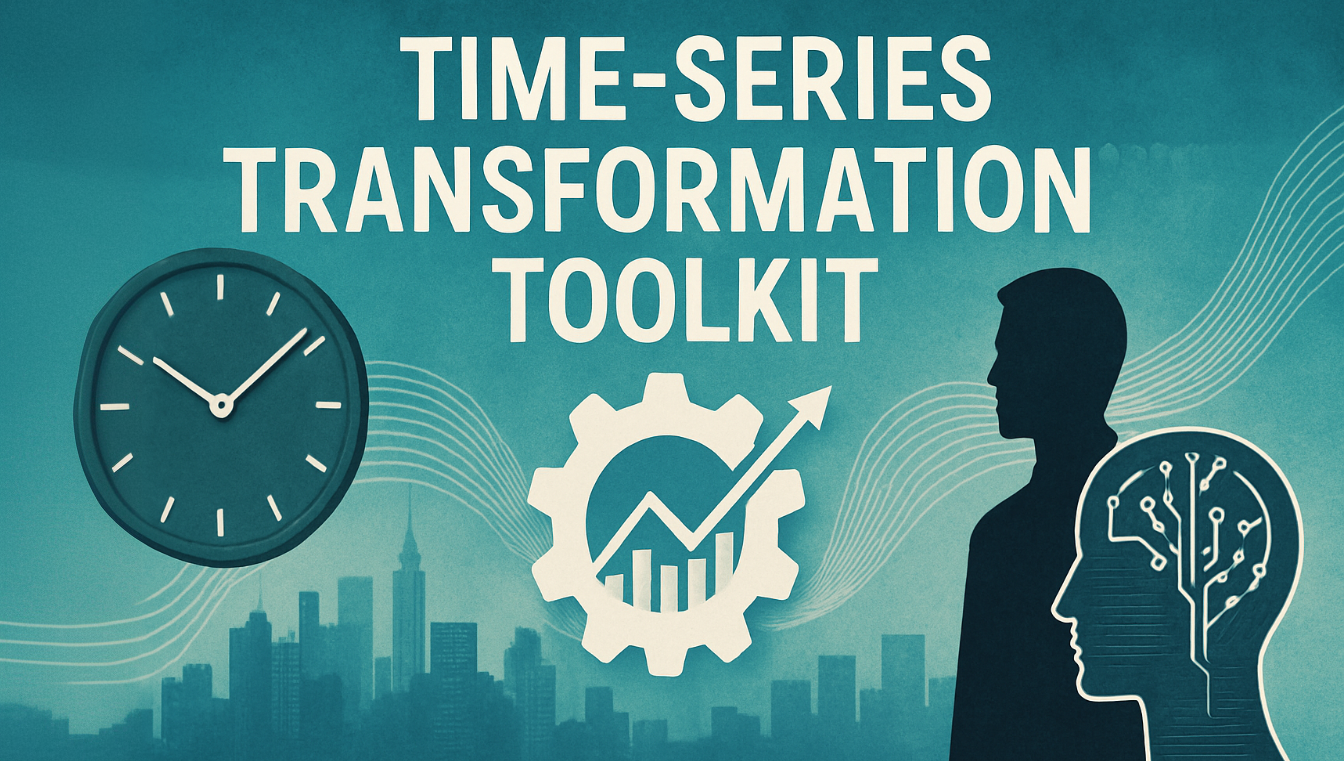Time Collection Conversion Toolkit: Superior Purposeful Engineering for Predictive Analytics
Photographs by editor | chatgpt
introduction
Time collection evaluation and prediction typically contain information transformation to uncover underlying patterns, stabilize traits resembling variance, and enhance the efficiency of predictive fashions. For instance, the time collection describing the sale of a product could point out robust seasonality and the impression of promotional occasions every week. In such circumstances, changing uncooked timestamps into categorical options resembling days of the week and vacation flags might assist the mannequin seize time dependencies and context extra successfully.
This text presents a reasonably subtle useful engineering method to assemble significant temporal options and making use of completely different transformations to predictive analytics.
Learn the way:
Add a number of delays to the time collection. Contains rolling statistics resembling rolling averages over the sliding time window. Apply variances to seize variations in counts over time intervals.
Mild hands-on diving
Use a typical time collection dataset that features every day recordings together with options resembling bike sharing dataset, date (dteday), every day bike rental depend (CNT), common temperature (temperature), day of the week (weekday), and holidays (vacation).
pd panda url = “https://uncooked.githubusercontent.com/deep-learning-with-pytorch/dlwpt-code/grasp/information/information/information/information/bike-sharing-dataset/day.csv” df = pd.read_csv(urse_date = parse_dates = read_csv([‘dteday’])DF[[‘dteday’, ‘cnt’, ‘temp’, ‘weekday’, ‘holiday’, ‘workingday’]]. head()
Import Panda As PD
URL = “https://uncooked.githubusercontent.com/deep-learning-with-pytorch/dlwpt-code/grasp/information/p1ch4/bike-sharing-dataset/day.csv”
DF = PD.read_csv(URL, parse_dates=[‘dteday’]))
DF[[‘dteday’, ‘cnt’, ‘temp’, ‘weekday’, ‘holiday’, ‘workingday’]].head())
With time collection information, it is very important set the date attribute as an index earlier than preprocessing and forecasting duties. On this case, that honor is given to the dtedy attribute, which is how it’s performed within the panda.
DF[‘date’] = pd.to_datetime(df[‘dteday’])df.set_index(‘date’, inplace = true)
DF[‘date’] = PD.to_datetime(DF[‘dteday’]))
DF.set_index(‘date’, Indoor=fact))
It additionally performs easy useful engineering duties (not superior but). Decide if the date is weekend and extract the month.
DF[‘is_weekend’] = df[‘weekday’].isin ([5, 6]).astype(int)df[‘month’] = df.index.month
DF[‘is_weekend’] = DF[‘weekday’].isin([5, 6])).ASTYPE(int))
DF[‘month’] = DF.index.month
Including LAG performance is a useful engineering approach utilized in time collection information, incorporating “short-term reminiscence” of previous data into particular data. On this means, the values of attributes, such because the variety of leases from yesterday, can be utilized as predictor attributes.
DF[‘cnt_lag1’] = df[‘cnt’].shift(1)df[‘cnt_lag2’] = df[‘cnt’].shift(2)df[‘cnt_lag7’] = df[‘cnt’].Shift(7)
DF[‘cnt_lag1’] = DF[‘cnt’].shift(1))
DF[‘cnt_lag2’] = DF[‘cnt’].shift(2))
DF[‘cnt_lag7’] = DF[‘cnt’].shift(7))
Importantly, the Shift(n) operate doesn’t calculate the typical worth of the required attribute over the previous N days or moments. It merely takes the worth that the attribute had an n-time prompt.
One other useful engineering approach that’s extraordinarily helpful in time collection prediction is what known as rolling statistics. Use the sliding time window to calculate the typical or different aggregated values over the interval outlined in that window. For instance, the next code provides two attributes to the dataset: One has a rolling common of seven days. That’s, the imply of the values for the 7 days earlier than a specific attribute and the rolling customary deviation for the 7 days.
DF[‘cnt_roll7_mean’] = df[‘cnt’].shift(1).rolling(window=7).imply()df[‘cnt_roll7_std’] = df[‘cnt’].shift(1).rolling(window=7).std()
DF[‘cnt_roll7_mean’] = DF[‘cnt’].shift(1)).rolling(window=7)).common())
DF[‘cnt_roll7_std’] = DF[‘cnt’].shift(1)).rolling(window=7)).std())
Rolling statistics show you how to achieve perception into how values like rental counts work over time, and show you how to simply establish tendencies and patterns of fluctuation.
Moreover, the distinction, which consists of calculating the distinction between the present worth of an attribute and the n occasions that worth, is beneficial not solely to have a look at the uncooked dimension, but in addition to disclose the way it adjustments over time.
This may be simply performed by reusing the Shift(n) operate mixed with column-level subtraction, as follows:
DF[‘cnt_diff1’] = df[‘cnt’] -DF[‘cnt’].shift(1)df[‘cnt_diff7’] = df[‘cnt’] -DF[‘cnt’].Shift(7)
DF[‘cnt_diff1’] = DF[‘cnt’] – DF[‘cnt’].shift(1))
DF[‘cnt_diff7’] = DF[‘cnt’] – DF[‘cnt’].shift(7))
Utilizing the above three characteristic transformations, some lacking values (NANs) are exhibited to shift and roll the primary few cases of the dataset. For instance, chances are you’ll have to resolve the best way to deal with them. For instance, you simply have to take away these rows from the dataset (if the time collection is massive sufficient, eradicating the primary few rows ought to usually not have an effect on predictive efficiency).
df_clean = df.dropna(subset =[
‘cnt_lag1’, ‘cnt_lag2’, ‘cnt_lag7’,
‘cnt_roll7_mean’, ‘cnt_roll7_std’,
‘cnt_diff1’, ‘cnt_diff7’
]))
DF_CLEAN = DF.Dropna(Subset=[
‘cnt_lag1’, ‘cnt_lag2’, ‘cnt_lag7’,
‘cnt_roll7_mean’, ‘cnt_roll7_std’,
‘cnt_diff1’, ‘cnt_diff7’
]))
Due to this fact, the results of transformation-driven useful engineering has resulted in a time collection dataset containing many helpful further info for predictive analytics. Nice job!
Conclusion
On this article, we introduced a number of methods for extracting and unlocking significant temporal options in time collection information utilizing delays, rolling statistics, and variations. When utilized correctly, these methods make uncooked time collection information appropriate for predictive analytics processes.







